

PEAK COMMERCIAL VEHICLE TECH
PAYLOAD + TOWING CAPACITY UNVEILED
STRENGTHENING CONNECTIONS
BUILDING BRIDGES

NAVIGATING BEYOND DIESEL EXPLORING YOUR EV CHARGING OPTIONS

RECOMMENDATIONS, PRIMARY TRIGGERS FOR TELEMATICS
WATCH + LISTEN SPRING 2024 CVB SUMMIT
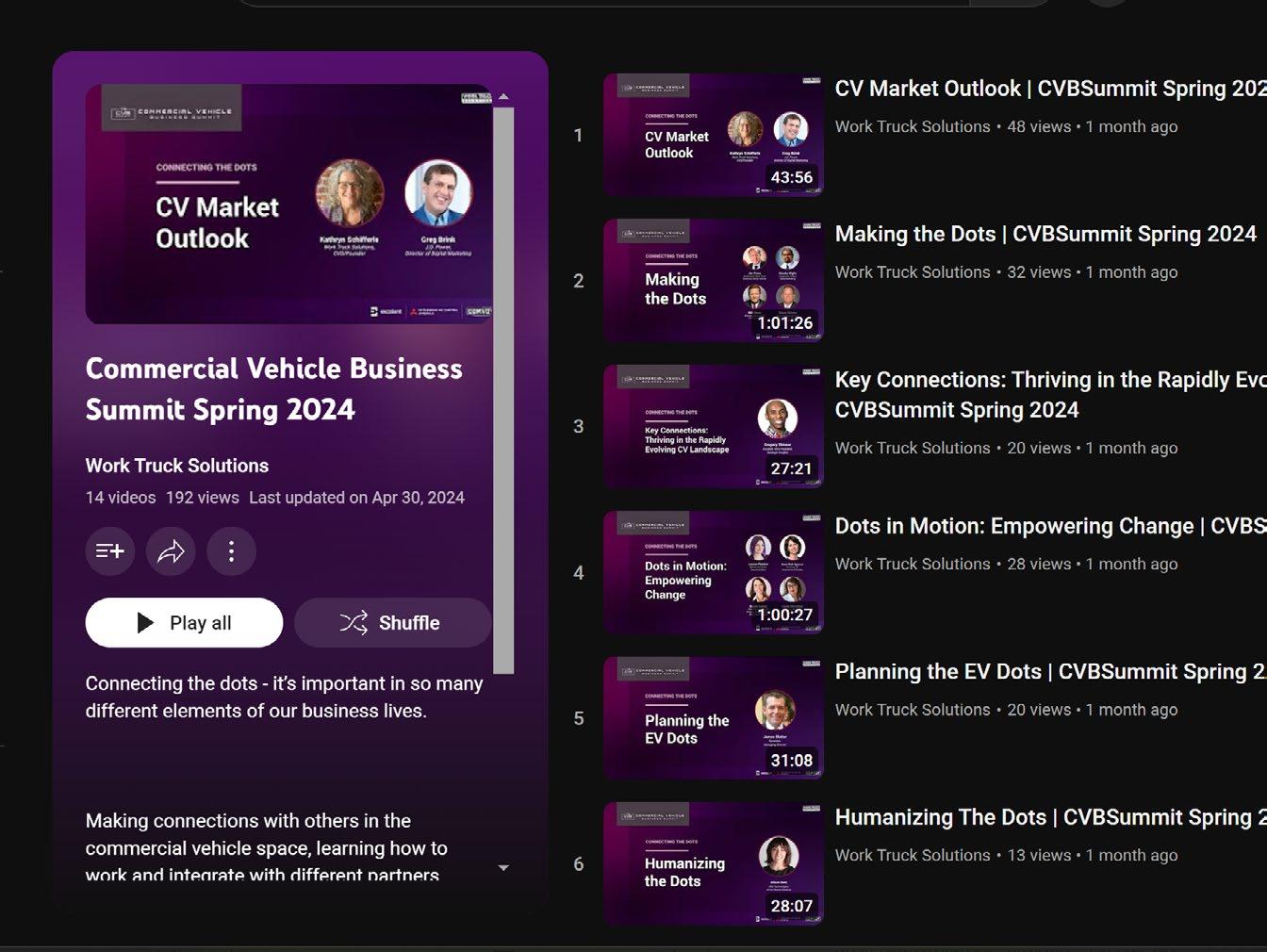
YOUR "BEING IN THE KNOW" TOOLBOX EDITION
JUNE 2024
8


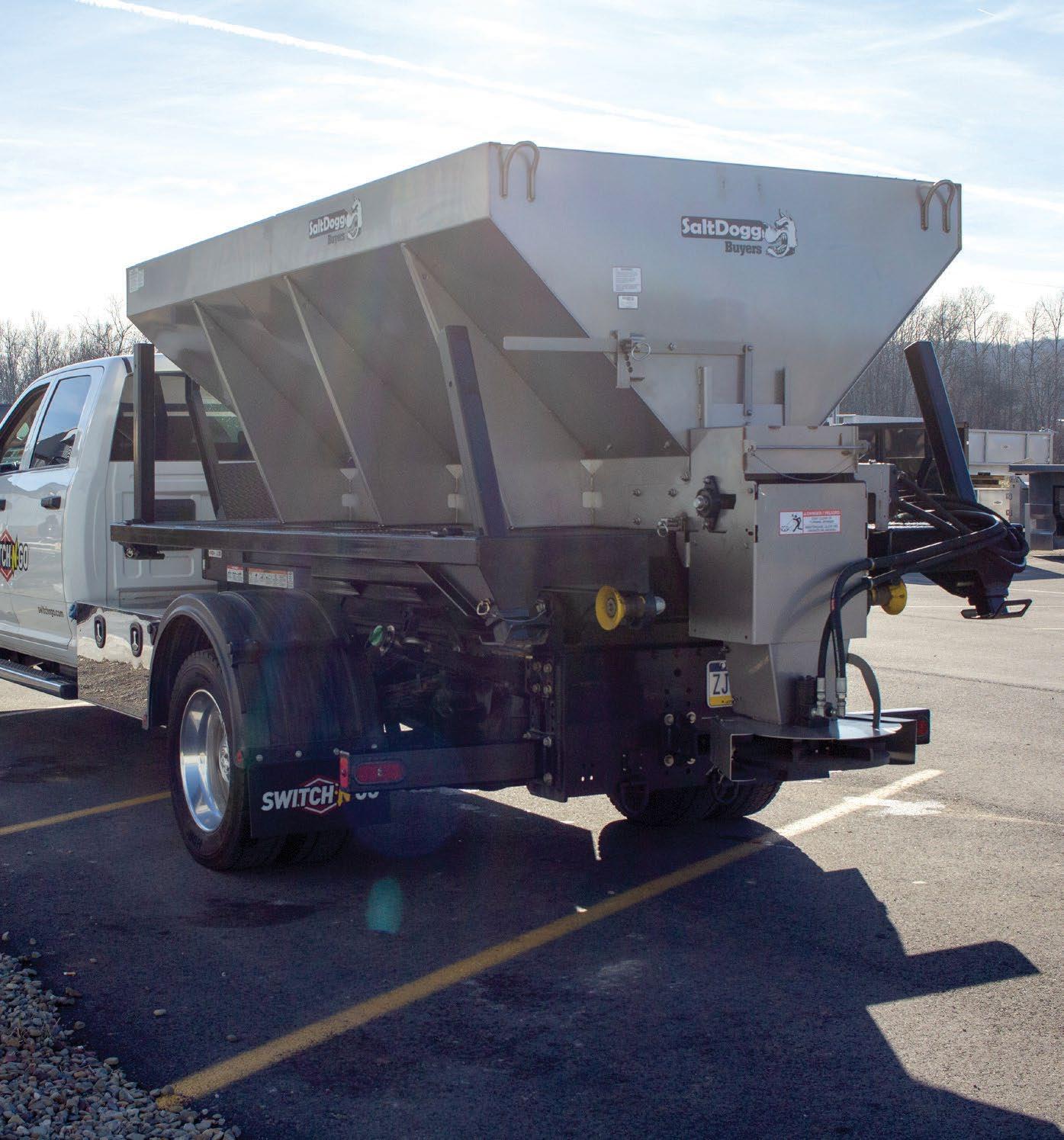

17 switchngo.com/find-a-dealer TAKE BACK YOUR TRUCKS!
winters
longer
trucks
our interchangeable truck
3 minutes you can switch from a Salt Spreader on a WorkReady™ Subframe to a Dump Body! Salt Spreader on WorkReady™ Subframe Stainless Steel Dump Body S079.2406 3MINUTES Over 30 interchangeable truck bodies available
Light
no
hold your
captive when you choose
bodies. In
LETTER FROM THE EDITOR
Being in the Know Will Set You Apart
Being in the know (and it’s so much better than being in the “no”) is essential for all of us in the commercial vehicle business, regardless of what role we play - truck pro, upfitter, OEM representative, vendor partner, reporter, consultant, and so forth.
The reality is, our customers - again no matter who they are - rely on us to know what’s happening in our ecosystem and subsequently being able to answer their questions, guide them with recommendations for their business, and suggest new products/solutions.
Sometimes, staying “current” can feel like a job all by itself. The speed of change always seems to be increasing and what we knew last year, and sometimes even what was true yesterday, is no

longer accurate. But, by simply reading through this publication - hopefully you do so regularlyand checking out the Commercial Vehicle Business Network website (CVBNetwork.com - feel free to bookmark it!), you’re already well ahead of a large percentage of your competitors, meaning you stand ready to help your customers and set yourself apart as the trusted partner they want and need. This edition has articles and content from many different areas across our industry, on a wide variety of topics from alternative fuels to press releases, from telematics research to recordings of sessions during a virtual event, and even ideas from Coach Ken's Commercial Truck Training. So, no matter your position, or title,
STEEL PGTB GOOSENECK BODIES
Now featuring B&W Turnoverball® hitches rated for 30,000 lb. gross trailer weight and 7,500 tongue weight, PGTB Gooseneck Hitch Truck Beds come loaded with integrated stop, tail, turn and backup lights in both the rear skirt and bulkhead and side rub rails for exceptional functionality and convenience. Choose models for either single or dual rear wheel chassis, along with 8’, 9’ and 11’ body lengths.
Regardless if you’re hauling a horse trailer or hay bales, PGTB Gooseneck Bodies are well‑equipped for the task at hand.
LEARN MORE AT KNAPHEIDE.COM

or type of company you’re part of, you’ll surely find something in our June Self-Development edition that can help you serve your customers better and improve your knowledge base; and it’s my sincere hope that you’ll find several ideas/stats/ concepts that you can apply to how you go about conducting your business to truly set yourself apart by being in the know and sharing your knowledge with others.
Steve Henning
 RUB RAILS
RUB RAILS
FORMED, INTEGRATED BULKHEAD
LED MARKER
RUGGED 1/8” THICK TREAD PLATE FLOOR 7-WAY TRAILER PLUG
The Knapheide Manufacturing Company 2024
B&W TURNOVERBALL® GOOSENECK HITCH
LIGHTS
©
Commercial Vehicle Pro | JUNE 2024 3
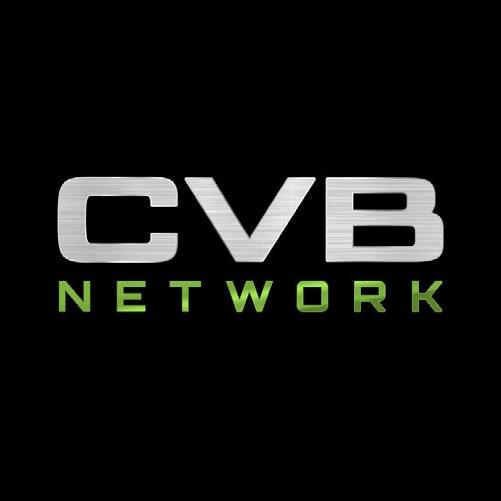










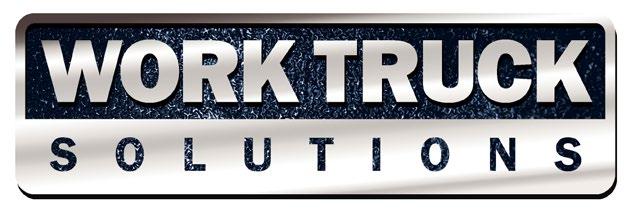
SPECIAL THANKS FOR THIS ISSUE TO: Adrian Steel Deist Industries, Inc. Driverge Vehicle Innovations Knapheide Manufacturing Company Mitsubishi HC Capital America Premier Truck Body, LLC OEM Systems, LLC Reading Truck Rockport Commercial Vehicles Transfer Flow Safe Fleet Scelzi Enterprises, Inc. Unicell Venco Venturo Industries LLC Work Truck Solutions COMVOY Commercial Truck Training For inquiries or articles or to be added to the mailing list: admin@cvbnetwork.com 1-800-413-9030 CVBNetwork/ Commercial Vehicle Pro 2485 Notre Dame Blvd., #370-130 Chico, CA 95928 Powered by: THE INDUSTRY'S TOOLBOX READ - LISTEN WATCH - NEWS Kristean von der Heiden, Sponsor Success Kelsey Anderson Sponsor Support Candy McCullom Business Development Kathryn Schifferle Executive Producer, CVBNetwork Ken Taylor "Coach Ken" Commercial Truck Training Shawn Horswill Sr. VP of Product Work Truck Solutions THANKS TO OUR CONTRIBUTING AUTHORS + SUPPORT STAFF
Henning, Executive Editor
Aoyagi, Media Director Ryan Day Assitant Editor JUNE 2024 | COMMERCIAL VEHICLE PRO 4
Steve
Carla


CONTENTS Letter from the Editor In The Highbeams Blue Oval/OEM Beat Spring 2024 CVB Summit Spring 2024 CVB Summit Spring 2024 CVB Summit Spring 2024 CVB Summit Expanding Ideas + Facilities Safety Cental: Reading Blog: NuPropel: NuPropel: RecommendationsCVPro-File: CVPro-File: Toolbox News Commercial Truck Training: Dealership Success: Being In The Know Will Set You Apart WTS, Knapheide Industry News In Review - WATCH Connecting the Dots for Fleet Sustainability Overcoming Electrification Challenges The Future in the Net-Zero Era In Scelzi's 45th Year Peaking Commercial Vehicle Tech Payload Towing + Capacity Unveiled Exploring Your EV Charging Options Navigating Beyond Diesel Primary Triggers for Telematics David Rittenhouse Mike Kelly 2024 ACT Expo Strengthening Connections Building Bridges 3 7 11 13 14 15 17 18 22 24 26 28 31 34 35 36 37 38 Commercial Vehicle Pro | JUNE 2024 5

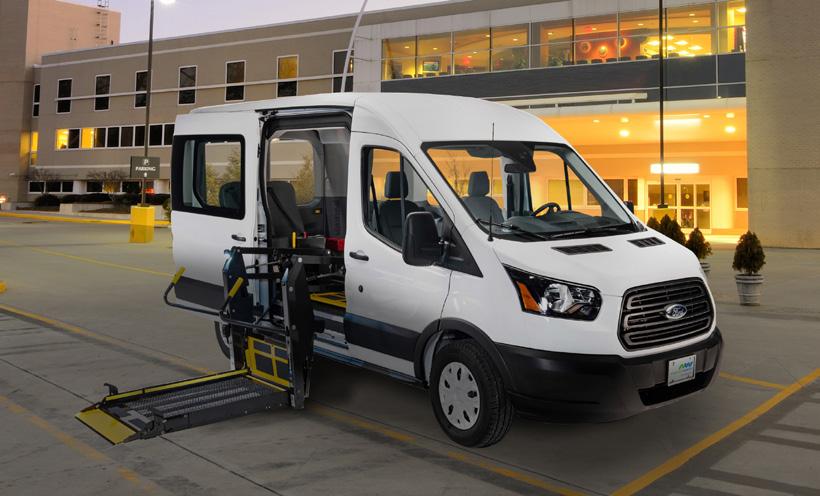
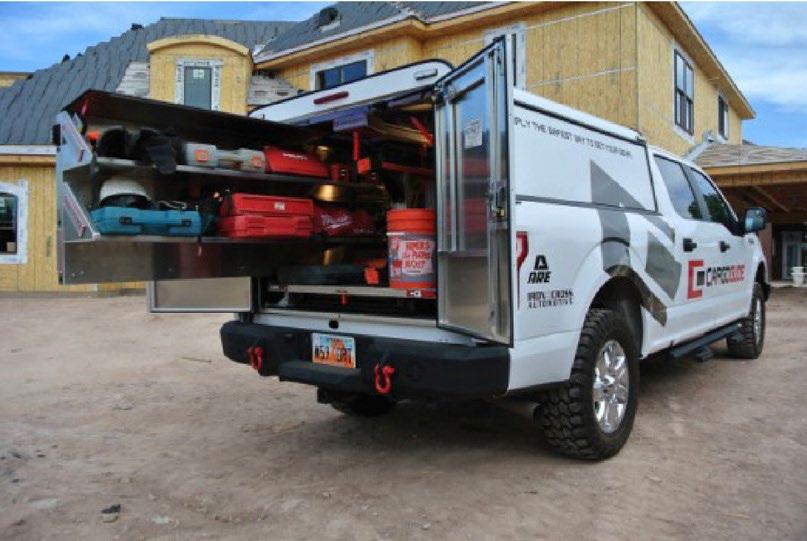
That’s what you get when you combine two of the nation’s leading upfitters.
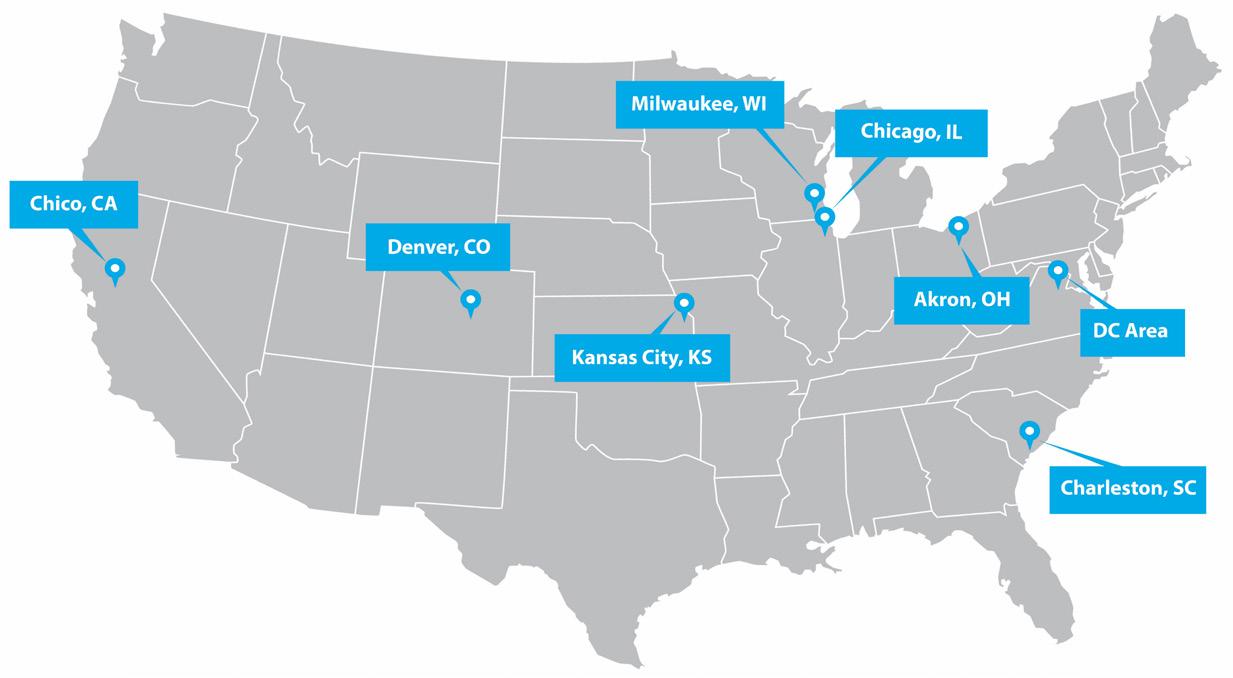
Now that Driverge has acquired U.S. Upfitters, it’s not just a question of what we can do for you, but also of exactly where and when. Call us and let’s get started! (855) 337- 9543


Better access to chassis Improved speed to market Lower transportation costs More convenience
In The
HIGHBEAMS
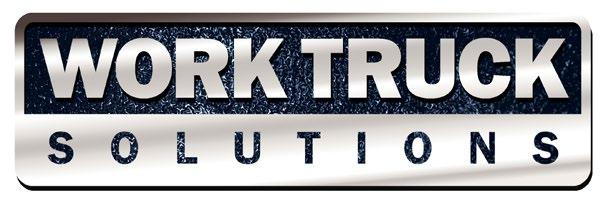
Q1 2024 COMMERCIAL VEHICLE MARKET ANALYSIS REVEALS
SIGNIFICANT SWINGS IN TRENDS
April 16th, 2024
Work Truck Solutions®, the leading authority on commercial vehicles, released their Q1, 2024 Commercial Vehicle Market Analysis, highlighting numerous key industry trends.
INVENTORY
• On-lot new vehicle inventory per dealer continues an upward trend, registering an increase of 12.7% QoQ and a very significant 93.1% YoY jump. Medium-duty vehicles are key contributors to this growth, constituting 52.4% of the on-lot inventory.
• New cutaways are significantly down in volume, by 24.0% QoQ and 21.7% YoY. Cutaways are generally the 4th highest in volume because they serve a variety of vocations, such as plumbing, construction, and HVAC, so these changes are impactful.
• New commercial EVs, although still comparatively small in overall inventory numbers, also saw a significant increase in on-lot numbers, up 51.5% QoQ and 67% YoY.
• Used inventory showed the opposite trend from new vehicles, with an 8.4% decline QoQ and 18.6% YoY.
PRICES
• The latest data reveals average prices for new commercial vehicles are holding relatively steady, with a modest QoQ increase of 0.1% and a slight increase YoY, up 4.2%. However, the Q1 2024 average price of $58,913 is recorded as the highest average price to date.
• New light-duty Battery Electric Vehicle pickup prices declined with a 2.5% drop QoQ and 18.1% YoY.
• In contrast to the growth in the new work truck space, the used inventory sector presented a different scenario.

Average prices of used work trucks and vans reported a decrease of 4.2% QoQ and 2.9% YoY. Price drops reflect the rising median mileage of used work trucks and vans, which has increased 6.9% QoQ and 7.8% YoY.
DAYS TO TURN
• Steady increases in inventory, record high prices, fewer leads, and high interest rates have precipitated a marked rise in Average Days to Turn (DTT) for new vehicle inventory, with an increase of 12.5% QoQ and a 21.8% YoY spike. Sitting at an average of 105 days in Q1 2024, new vehicle DTT is the highest it's been since Q4 2020.
• The average DTT for used vehicles, however, showed a slight QoQ decrease of 4.7% QoQ, and a YoY decrease of 18.4%.
Sales
• As indicated by the increased DTT, new vehicle movement, or sales, per dealer, showed a declining QoQ trend of 12.6%. This is partly due to the increased inventory relieving some of the pent up demand, but also due to the market dynamics of increased interest rates, and pressures and considerations towards new options for lowering emissions. However, the data still registered an 11.2% increase YoY.
• As a whole, new commercial EV sales remained virtually flat QoQ.
• Sales of used vehicles fell at an accelerated rate, with the average number of work trucks/vans moved per dealer decreasing 10.2% QoQ and 23.2% YoY.
VOCATION
• The distribution of body types QoQ is stable, with service bodies still in the top spot.
• YoY there is a decline in the totality of vans, from empty cargo vans to minivans that were filling in for the decimated van inventory during the Pandemic, due to the sudden increase in delivery demand.
With the reduced inventory of cutaways, we will keep an eye on the demand from top users in those vocations:
1. Cargo/Freight Transport
2. Plumbing
3. Construction
4. Contractor
5. HVAC
Together, these top 5 vocations comprise roughly 61% of demand for cutaways on all our platforms (dealership sites, OEM Tier-1 sites, Upfitter Locators and Comvoy.com) combined.
TAKEAWAYS
"As we unveil our Q1 2024 data findings, it’s clear there is improved availability of new work trucks, vans and SUVs, which is welcome news to buyers after the last few years of restricted commercial vehicle inventory," said Aaron Johnson, CEO of Work Truck Solutions. Johnson noted that the swell in new vehicle inventory, coupled with increased Days to Turn (DTT), is sparking renewed competition among commercial vehicle dealers. As a result, it is critical for dealerships to differentiate themselves by embracing digital merchandising tools that enhance the buyer experience. Furthermore, Johnson commented that “these tools should also streamline operations by providing data analytics that aid intelligent stocking, marketing and inventory management strategies, and decision-making. A digital-first approach is increasingly crucial for commercial vehicle dealers.”
Johnson concluded his assessment by saying, "Events such as the Pandemic, high-interest rates, and now the tragic destruction of the Francis Scott Key bridge remind us how important it is to stay vigilant in our customer focus, and also underscore the vital role that timely data, coupled with the right solutions, play in powering the success of commercial vehicle operations across the nation. At Work Truck Solutions, we’ll continue to provide our customers with innovative solutions to help them thrive during these dynamic market conditions."
Commercial Vehicle Pro | JUNE 2024 7
HIGHBEAMS In

UNVEILING
THE FUTURE: DEBUTING THE ALUMINUM KNAPHEIDE MECHANICS SERVICE TRUCK
April 22, 2024
The Knapheide Mechanics Service Truck (KMS) is a solution that has been trusted by work truck owners and operators for years, chosen for its durability and weight savings. And now, there's a new option on the horizon for those looking to invest in even longer-lasting, lighter-weight workstations on wheels.
INTRODUCING
THE AKMS16 Knapheide showcased its Aluminum KMS16-09 prototype in Indianapolis, Ind., at the National Truck Equipment Association’s Work Truck Week Expo in March. The AKMS16 combines steel and aluminum: The crane compartment and understructure are crafted using steel to provide strength, and with its aluminum side packs, users gain an additional 530 lb. of payload capacity (compared to Knapheide’s currentlightest mechanics truck option – the standard KMS16).

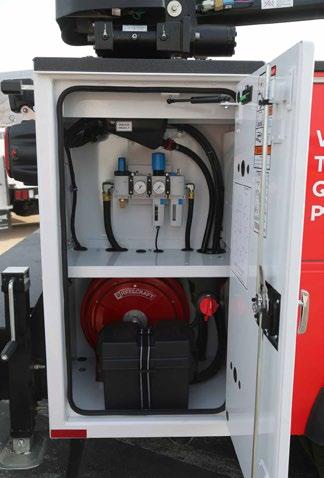


BUT HOW, EXACTLY, DOES THIS BENEFIT USERS?
The AKMS16's payload capacity will allow users to haul all the tools and components they need to job sites, without having to increase their chassis class. But that’s not all.
In addition to increasing available payload, the side pack compartments are designed to enable easy organization. (After all, organization is paramount for efficiency.) So, users will have the option to include CTech extreme-duty aluminum mechanics 7-drawer sets and bolt bins (both standard options) in the compartments to ensure that all tools and components have a place, or can choose other organizational equipment to add. But either way, users can expect a reduction in clutter and search time.

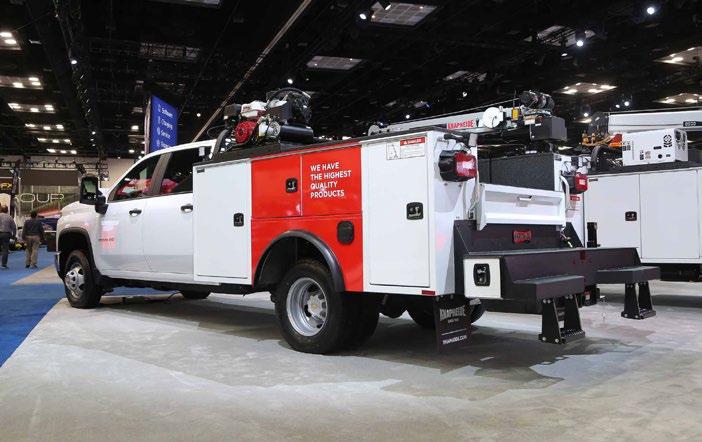
WHEN CAN YOU EXPECT THIS SOLUTION TO HIT THE MARKET?
Well, the AKMS16 is still in testing, and its release date has not yet been announced. But once it is released, you can expect to see the following versions added to our standard product lineup: AKMS1609, AKMS16-09-MD, AKMS16-09R, AKMS16-09R-MD, AKMS16-11, AKMS16-11-MD, AKMS16-11R and AKMS16-11R-MD.
So, stay tuned and keep checking our blog for more information on its release. And in the meantime, check out the photos below to see what’s in store for the future of light-weight mechanics trucks at Knapheide.

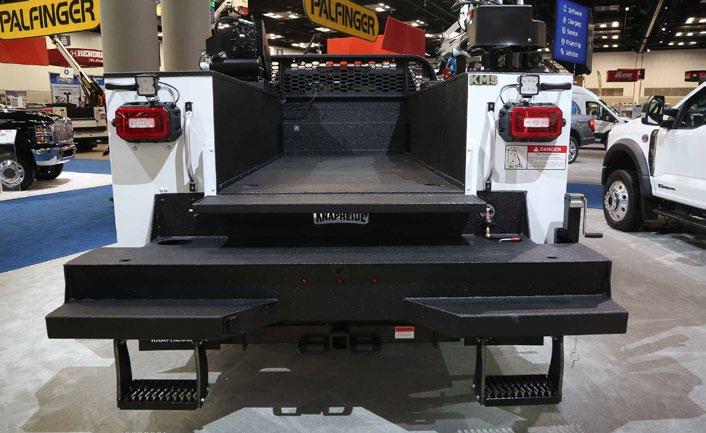

The
JUNE 2024 | COMMERCIAL VEHICLE PRO 8

WORK TRUCK SOLUTIONS’ CUTTING-EDGE MERCHANDISING FEATURES
May 7th, 2024
Work Truck Solutions®, the leading authority on commercial vehicles, continues to see vehicle inventory being replenished, and is excited to highlight several features that revolutionize how work truck buyers interact with dealership websites. These merchandising innovations not only make the shopping experience more engaging, but also significantly streamline the process of finding and purchasing commercial vehicles online.
Work Truck Solutions recognizes the distinct demands of commercial vehicle dealerships and the critical influence that user experience has on sales performance. In response, the company is proud to introduce an array of innovative features designed to streamline and enhance the buying process for commercial vehicle buyers.
NEW INNOVATIONS TO DRIVE SALES BY TODAY’S COMMERCIAL VEHICLE BUYERS
Financing: Small/medium-sized business shoppers may view financing as a barrier to their purchasing process. To overcome this, Work Truck Solutions has delivered a financing widget to simplify the process, enabling buyers to estimate payments, be pre-qualified, and engage directly through the dealership's website for financing.
Transporting: In today’s environment, it is common for commercial vehicle buyers to shop outside their local market. With a website widget that alleviates the complexities of vehicle transport, dealership sales teams and their buyers can effortlessly quote, schedule, and track vehicle transportation.

Vehicle Alerts: Vehicle shoppers appreciate being empowered to choose email alerts for vehicles about which they have inquired. Notifications are sent when there is a price change or if the vehicle leaves the lot, keeping these potential buyers informed and engaging them to regularly revisit the dealership’s site.
KEY MERCHANDISING FEATURES DESIGNED TO ENHANCE THE USER EXPERIENCE
Custom Vehicle Carousel: Catch the eyes of business buyers by placing a customized carousel on select areas of the dealer retail site, or target a specific vocation through a custom page that includes a tailor-built carousel focusing on specific criteria such as body type, body manufacturer, or any other use case searches, making it easier than ever to direct potential buyers to commercial listings.
Banner Promos: Shoppers intent on searching for their next commercial vehicle will appreciate direct promotions on banners that feature special offers and dealer services. Simple and clean, these banners can appear at selected intervals (e.g., after every vehicle listing, every fifth vehicle, etc.), providing maximum visibility and engagement.
Recently Viewed Carousel:
Encourage continued visitor engagement with a dynamic carousel that displays vehicles site visitors have recently viewed, furthering their shopping experience and ease of use.
Similar Vehicles Carousel: Enhance the visitor’s discovery process and their commercial vehicle purchase odds by presenting additional on-lot vehicle choices similar to the ones they have been viewing.
"Our mission at Work Truck Solutions has always been to revolutionize the commercial vehicle market by empowering dealerships with the solutions they need to succeed in a digital-first world," stated Kathryn Schifferle, Founder and Chief Vision Officer of Work Truck Solutions. "These platform features underscore our dedication to streamlining the purchase process, ensuring that our dealerships can offer unparalleled convenience and efficiency to their customers. We're always excited to offer our partners ways to elevate their operations, serve their customers, and positively impact their bottom lines, and we’ll never stop looking for ways to continue to do so."


HIGHBEAMS In The
Commercial Vehicle Pro | JUNE 2024 9
ELEVATE YOUR FLEET
Give your operation a lift with equipment you can depend on –durable, made in America, and ready to handle every challenge.
From light-duty electric cranes to full heavy-duty upfit packages, Venturo delivers the rugged performance your jobs demand.

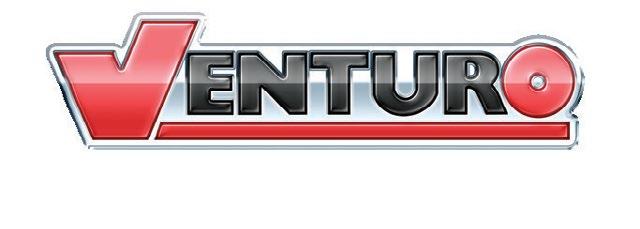
FIND THE CRANE FOR YOU AT VENTURO.COM
OEM BEAT

ISUZU ANNOUNCES A NEW GENERATION OF THE REFRIGERATED BODY – IT’S ELECTRIC!

DAIMLER TRUCK UNVEILS BATTERY ELECTRIC
AUTONOMOUS FREIGHTLINER ECASCADIA
TECHNOLOGY DEMONSTRATOR

PENSKE ENERGY FORMED TO ADVISE AND SUPPORT
COMMERCIAL FLEETS ON EV INFRASTRUCTURE

MACK TRUCKS EXPANDS CERTIFIED EV DEALER NETWORK TO 53 LOCATIONS

MOTIV ELECTRIC TRUCKS LAUNCHES ARGO – A NEW TRUCK CONFIGURABLE FOR MULTIPLE APPLICATIONS

Commercial Vehicle Pro | JUNE 2024 11



SPRING 2024

Connecting the Dots - that was the theme of the recent Spring 2024 Commercial Vehicle Business Summit hosted by Work Truck Solutions, along with sponsors Escalent, Mitsubishi HC Capital America and Comvoy.
The concept for the virtual event revolved around the connections that are so important in our business. After all, the work truck and van ecosystem is all about relationships with customers, upfitters, colleagues, OEMs and so on. And making these connections, hearing from other experts, is a key way to how we improve our:
• Understanding of what’s around the corner
• List of contacts
• Ideas about products, services and concepts
• Knowledge of best practices and ways to implement them

So consider taking some time to check out the recordings from the event - you just might learn about that next “big thing” that takes your commercial vehicle business to the next level.
WATCH THE SESSIONS HERE



LISTEN TO THE PODCAST
CONNECTING THE COMMERCIAL VEHICLE BUSINESS DOTS
Commercial Vehicle Pro | JUNE 2024 13

CONNECTING THE DOTS FOR FLEET SUSTAINABILITY STRATEGIES
There is a significant drive for the commercial vehicle industry to transition to more sustainable fleets. While innovative technologies like commercial EVs and hydrogen fuel vehicles are emerging to reduce the carbon footprint of commercial transportation, stakeholders embarking on this green transition are confronted with a myriad of challenges.
Stakeholders include every organization involved in manufacturing, upfitting, selling, and operating net-zero vehicles and everything in between. All of the stakeholders involved in the decarbonization of commercial transportation must begin to address, in a holistic way, strategies
for vehicle insurance, financing, TCO, and eventually remarketing, which are unique to these new types of vehicles.
Much discussion and education are necessary before product providers and end-users are adequately prepared to successfully deploy the technologies being imposed on them.
“We see companies thinking it’s going to be a one-for-one swap, like, ‘Okay, I’m bringing in this EV to replace this [diesel] truck’,” says Gregory Skinner, VP of Auto and Mobility at Escalent. “But it’s not that easy. You really have to change the way you do business.”
At the Commercial Vehicle Business Summit Spring 2024,
Gregory Skinner led a discussion panel with contributions from Christina Ameigh from Lion Electric, Jill Trotta from 5801 Consultants, and Sidney Miller from Midway Ford, delving into crucial topics within the commercial vehicle industry and the shift toward zero-emission vehicles. Their discussion also underscored the significance of incorporating advanced technologies and telematics to enhance fleet operations and the importance of robust support systems to sustain these technologies. The diverse viewpoints of the panelists provided a comprehensive analysis of the current and prospective trends in the industry.
Watch the full discussion below:



First Published on Comvoy.com LISTEN TO THE PODCAST WATCH THE SESSION HERE JUNE 2024 | COMMERCIAL VEHICLE PRO 14

OVERCOMING CHALLENGES IN FLEET ELECTRIFICATION WITH SIMULATION TOOLS
As businesses seek to reduce their carbon footprint, the adoption of electric vehicles has become a key strategy. However, this transition is fraught with challenges. Navigating fleet electrification requires a deep dive into two essential considerations: the "Why" elucidates the reasons behind the transition, while the "How" outlines the roadmap for implementing it effectively. The “How” can also include simulation tools that help businesses understand the impact of different scenarios on their operations to make informed decisions.
THE "WHY" OF FLEET ELECTRIFICATION
Understanding the underlying motivations for the move towards electric fleets is crucial for aligning business strategies with sustainable outcomes. The advantages include:
Environmental & Sustainability Advantages
Electric vehicles offer substantial benefits for the environment, drastically cutting emissions and reducing reliance on non-renewable energy sources.
Economic Incentives & Cost Savings
Transitioning to EVs can lead to significant cost reductions over time. This includes lower fuel costs, maintenance expenses, and potential tax incentives that, when combined, can significantly improve the bottom line.
Enhancing Brand Reputation
Adopting electric vehicles can significantly bolster a company’s image, resonating with customers and stakeholders who prioritize environmental responsibility, thus fostering a green brand identity.

THE "HOW" OF FLEET ELECTRIFICATION
Addressing the logistical challenges of transitioning to an electric fleet requires careful planning and the right tools. Companies should develop a long-term strategy for fleet electrification, including an assessment of their current fleet and how it can be adapted to accommodate electric vehicles. This will help them identify any potential challenges and opportunities that may arise during the transition process. Elements of transition to evaluate include:
Infrastructure or Charging Considerations
A primary logistical concern is deciding whether to use public charging stations or install the necessary charging infrastructure at company facilities. Considerable strategic planning is necessary to determine which will yield the best ROI.
Vehicle Selection & Range/Load Anxiety
Selecting the appropriate electric vehicles that meet the requirements for range and functionality is vital, alongside strategies to mitigate range anxiety among drivers.
Financial Implications & Return on Investment (ROI)
While upfront costs for electric vehicles can be higher, the long-term ROI is favorable owing to lower running costs. Incentives and grants available to support these investments are important to consider for financial planning.
USING SIMULATION
TOOLS TO ADDRESS THE “HOW” Simulation tools are indispensable in the "How" phase and provide a virtual environment to test and refine fleet electrification strategies. This analytical framework helps organizations anticipate potential issues, develop solutions, and minimize the risks associated with such a significant operational shift. Transition considerations that simulation tools help with include:
• Transition planning
• EV types & optimizing vehicle selection
• Infrastructure needs & charging options
• Cost analysis
• Routing optimization
CONCLUSION
The challenges inherent in this transition demand a strategic approach where simulation tools are not a luxury but a necessity, providing clarity and foresight.
Discover how to facilitate your fleet's transition to electric vehicles with the insightful video, "Planning the EV Dots," from the Commercial Vehicle Business Summit Spring 2024. Join James Slatter of Dynamon as he unveils the cutting-edge software, Zero, proven to streamline the EV transition for fleet operators.


First Published on Comvoy.com LISTEN WATCH Commercial Vehicle Pro | JUNE 2024 15

* Photos include non-standard/optional equipment. Also available on most Cab Chassis models. The lowest entry height in the industry. Cab-to-Cargo walkthrough options available. THE PREFERRED AND PROVEN WORK TRUCK FOR ELECTRICAL, PLUMBING, HVAC AND CONSTRUCTION CONTRACTORS. READY TO WORK. 888-711-1600 | ROCKPORTTRUCKS.COM A FOREST RIVER BRAND FORESTRIVERINC.COM

THE FUTURE OF THE COMMERCIAL VEHICLE INDUSTRY IN THE NET-ZERO ERA
As we consider the future of the commercial vehicle industry, it is clear that we are on the cusp of a new era. The future of commercial vehicles will be shaped by several factors, including the increasing demand for last-mile delivery and technological advancements. However, one commonality within the dynamic field of commercial transportation is the inevitable move toward net-zero emissions.
As environmental concerns comprise an ever-critical cornerstone of societal and political discourse, the commercial vehicle industry stands at the crossroads of change. U.S. federal mandates and California's trailblazing regulations, such as the Advanced Clean Trucks regulation, Advanced Clean Fleets regulation, and Clean Transportation Program, are testaments to this shifting paradigm. They also inspire similar policies throughout the country, shaping a national landscape undergoing a revolution.

CHALLENGES TO THE ADOPTION OF NET-ZERO VEHICLES
The road to all things green and gleaming with zero emissions is a path paved with challenges. Key hurdles include:
• The rapid pace of technological change, which is both promising and yet not fully matured.
• Lagging standardization across technologies and infrastructure.
• Unclear environmental impact assessments causing skepticism among potential adopters.
• Downtime and maintenance concerns that arise with new vehicle types.
• High initial investment and an often unclear total cost of ownership (TCO), leading to hesitancy among potential buyers


Overcoming adoption anxiety can be facilitated by:
• Clear, useful information that galvanizes confidence, adapted to every stage of the buyer's journey.
• Platforms like Comvoy.com, which provide detailed features of net-zero vehicles that are currently available, and also offer a seamless bridge to vehicle sellers, catalyzing action.
THE DIVERSE PATHS TO DECARBONIZATION
The complex nature of fleet operations indicates that the path to green fleets will be just as multifaceted as the usage models involved. Factors such as distance, cargo requirements, and fleet size help discern the most efficient and sustainable technologies suitable for each unique business application. We must acknowledge that decarbonization will not be accomplished with a one-size-fits-all solution, but with several dynamic, tailored ones.
Delve deeper into these topics by watching the following conversation between Kathryn Schifferle, founder and chief vision officer at Work Truck Solutions, and Greg Brink from J.D. Power, as they explore these crucial issues.

Commercial Vehicle Pro | JUNE 2024 17
WATCH
First Published on Comvoy.com LISTEN TO THE PODCAST
EXPANDING IDEAS & FACILITIES IN SCELZI’S 45TH YEAR
By Bill Vander Plaats, SCELZI PREMIUM TRUCK BODIES

It has been said it is hard to teach an old dog a new trick, but if the old dog shows no signs of slowing down, that might be the best course of action. As Scelzi Enterprises celebrates their 45th year producing premium truck bodies for Ford chassis cabs and others, the drawing board is full of new tricks to learn and new “dog houses” to construct. Ask Mike Scelzi, the founder and co-owner. Along with brother Gary they continue to plan for an even more successful NEXT 45 years. Among the new tricks their team is learning are upgrades to computer systems, expanding the use of robotics in their production facilities, and determining how best to use artificial intelligence tools on the production floor and in dayto-day operations. None are easy decisions, and each will require their team to endure some pain during the transition. “You can’t just stand pat, or you fall behind,” Mike says. “The world is changing quickly, and we must be sure we take advantage of any improved ways to do things.”
A GROWING DELIVERY FLEET
Prompt delivery of completed trucks and bodies to dealers is a priority at Scelzi, and their fleet of
tractor-trailers has recently grown to 12 to meet this need. The fleet also moves some sub-assemblies and raw materials between Scelzi locations in Fresno, Riverside, Shafter, Tacoma, and LaSalle (Denver). More trucks and drivers are planned for later this year. “I was a truck driver myself early in my career,” states Scelzi, “so I have a special respect for the people who have this challenging job – including those on our team. We try to make their lives as easy as we can, while still following the growing list of regulations in this area. I guess that is one secret to our success – we have walked a mile or two in the shoes of our customers and know what they deal with on a daily basis.”
EXPANDING FACILITIES
In addition to new systems, procedures, and fleet vehicles, the need for more physical space is an ongoing challenge for Scelzi. Last year was their 15th consecutive year of double-digit sales growth. The Scelzi team is constantly on the lookout for expansion space opportunities for both sales and production, at their main location in Fresno and elsewhere.
In June of 2024 the company is finalizing renovations of the property it acquired last year from Elliott Manufacturing. The Elliott facility adjoins Scelzi’s current Fresno properties and adds approximately 5 acres of land and 50,000 square feet of building
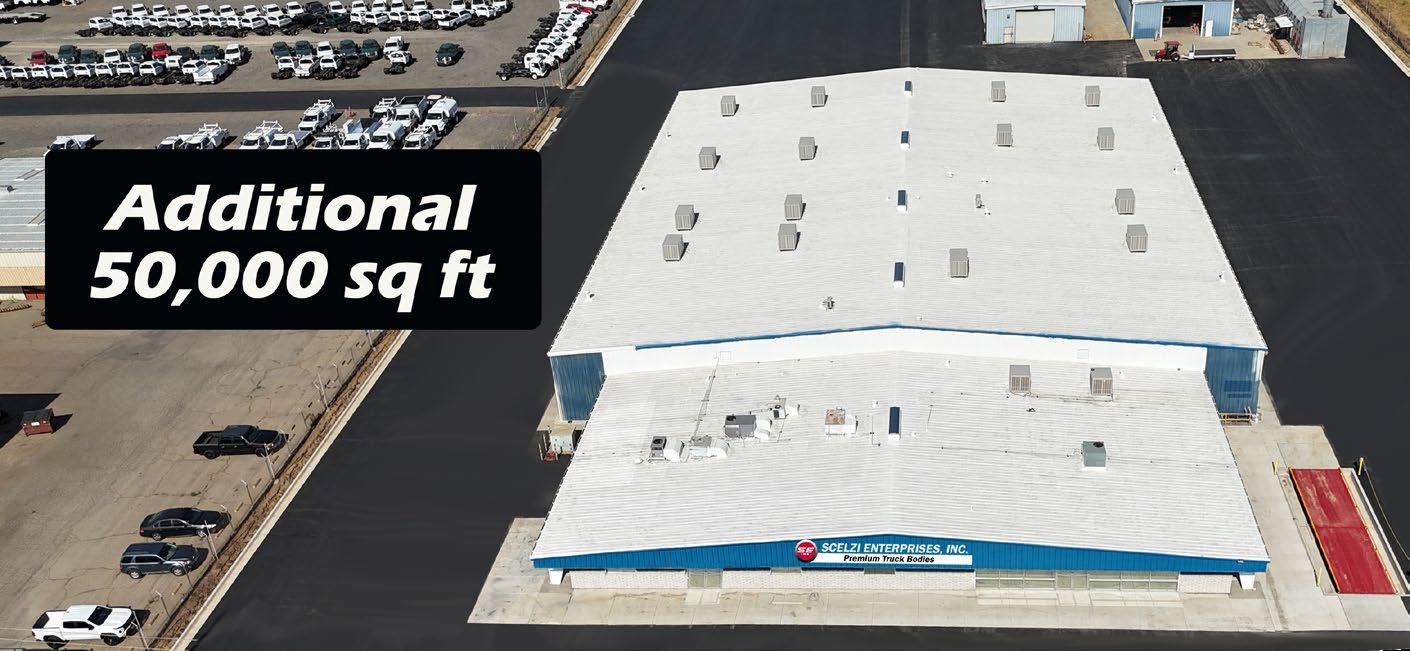

JUNE 2024 | COMMERCIAL VEHICLE PRO 18
space to Scelzi’s Fresno footprint. This expansion follows on the heels of other recent expansions in Tacoma (WA) and Shafter (CA).
Initially the new “Elliott facility” will house Human Resources, Service and Repair, and several other support departments for both Sales and Production teams.
“We have been cramped in Fresno for several years,” states owner Mike Scelzi, “and have made offers to purchase land from just about every neighbor we have there. We are glad to finally close this deal and get the building ready to roll. We also continue to pursue our expansion plans outside of Fresno and will make those moves when the time and price is right”.
More computers and robots, fleet additions and square footage.
The Scelzi story continues. It all began in 1979 when brothers Mike
"IT HAS BEEN SAID IT IS HARD TO TEACH AN OLD DOG A NEW TRICK, BUT IF THE OLD DOG SHOWS NO SIGNS OF SLOWING DOWN, THAT MIGHT BE THE BEST COURSE OF ACTION."
and Gary Scelzi borrowed $20,000 from their father to start welding truck bodies in their garage. Fortyfive years later, Mike is no longer the lead welder and Gary no longer paints every truck body himself
– but their pride and passion for Premium workmanship has not waned.


FOR MORE INFORMATION, CONTACT SCELZI ENTERPRISES OR VISIT WWW.SEINC.COM
FACILITIES
EXPANDING IDEAS &
Commercial Vehicle Pro | JUNE 2024 19


SAFETY CENTRAL
COMMERCIAL VEHICLE TECH IS PEAKING RIGHT NOW. HERE ARE 4 EXAMPLES OF HOW.
In
the realm of work trucks and commercial vehicles, there’s no shortage of emerging technologies these days.
In fact, in any given quarter, you’d find that an engineer from any of Safe Fleet’s brands may be cooking up an innovation that makes the road safer, fleet by fleet. From features that allow for distractionfree delivery routes, to cameras that use the power of machine learning, the commercial vehicle segment is experiencing a boom time in terms of safety technology.
HERE ARE 4 PRIME EXAMPLES OF JUST THAT.
SMOOTH, CONTROLLED LADDER DEPLOYMENT
Anyone who’s ever had to load or unload a work ladder from the roof of a van will attest: it can be cumbersome, especially when factoring in the operator’s physical stature or preexisting conditions. A ladder rack built with ergonomics in mind addresses that concern, but not without tackling a major issue: the safe descent of heavy/super heavy-duty ladders.
When gravity and weight combine, a heavy ladder’s fall can easily injure a worker—and that’s why the Prime Design ErgoRack’s signature

Blue Cylinder update matters: it turns that rapid, sudden fall into a controlled, manageable descent. Its temperature-stable hydraulic fluid allows for a safe rate of descent no matter the season, as cold and heat affect the viscosity of hydraulic fluids and determine the speed of a drop.
QUICK TO THE PUNCH (OR KICKS, IN THIS CASE)
Efficiency can mean shrinking down, and this is true in the case of the Nissan Kicks, a subcompact SUV being adopted by commercial fleets. Its compact, light body makes it a sensible alternative to large trucks when it comes to tight urban spaces. While its stock features are good enough for the average consumer, a work truck fleet would need more in the way of safely transporting equipment and cargo.
American Van has been quick to the punch in terms of catching up to the trend, with two Nissan Kicks-specific products that cater to the emerging demand: a Nissan Kicks Flooring Kit made in collaboration with Legend Flooring and a Nissan Kicks Wire Partition that needs no drilling to install and safely separates the cargo area from the driver and passenger seats. According to American Van, installation of these two products happens quickly enough to have your vehicles back on the road with minimum downtime!
SPEEDY, SILENT, AND STRONG SHELVING
Exactly how innovative can last mile delivery shelving get? More than you’d think…

JUNE 2024 | COMMERCIAL VEHICLE PRO 22
SAFETY CENTRAL
While maximizing space and organization are the primary needs that any good shelving system fulfills, it’s the user-centric features that separate a great one from the pack.
Prime Design’s FoldPro delivers one-hand operation, an improved payload of 400 lbs per shelf, and minimal vibration or noise—all made possible by a small yet ingenious piece of engineering: its spring retention shelf latch system . What's the big deal about this little latch? Well, it’s the mechanism that holds each shelf in place, whether open or closed, giving drivers peace of mind that everything is secure. Now, drivers can remain totally focused on the road ahead and not the shake, rattle, and roll of packages behind them.
SMART CAMERAS MAKE SMARTER DRIVERS
If there’s one application that AI can go a long way towards, it’s for commercial vehicle safety cameras. With the RVS 1080P Wide Angle Advanced AI Camera, drivers can take advantage of advanced vehicle, cyclist, and pedestrian detection, down to their body part and posture recognition. The power of machine learning is aided by 3 color-coded detection zones that give visual proximity alerts and audio alerts right from an integrated monitor. When it comes to situational awareness, few things can top multiple AI-powered cameras around your vehicles combined with proximity alerts.
CONCLUSION
It’s not enough to just hop onto trends or innovate for the sake of
it. While these solutions can work wonders on their own, they’re even more effective when combined for a comprehensive solution. Safe Fleet is adept at combining and customizing innovative technologies to make systems that safeguard vehicles from every angle.
Contact a Safe Fleet expert to learn just how we can customize a solution specific to your needs.


By Kevin Anderson Commercial Vehicle, SafeFleet Kevin.anderson@safefleet.net Commercial Vehicle Pro | JUNE 2024 23

PAYLOAD & TOWING CAPACITY UNVEILED: WHAT YOU NEED TO KNOW
Whether towing or hauling cargo, it’s important to know the capacity a vehicle can handle. Exceeding this value can cause excessive wear on a truck’s engine, transmission, tires, brakes and other components. Learn about towing capacity, payload and other calculations you will need to make to help your customers get the most from their trucks.
What’s the difference between payload and towing capacity?
A truck’s payload capacity refers to the maximum amount of weight you can safely add to a truck’s cargo area in addition to its curb weight (or empty weight). Towing capacity, on the other hand, refers to the maximum weight that a truck can tow after factoring in the weight of the truck and any cargo.
Many terms are used in the industry — GVWR (gross vehicle weight rating), CW (curb weight), GCWR also known as GCVWR (gross combined vehicle weight rating) and many others. It is important to comprehend these and other related terms to ensure a clear definition for each.
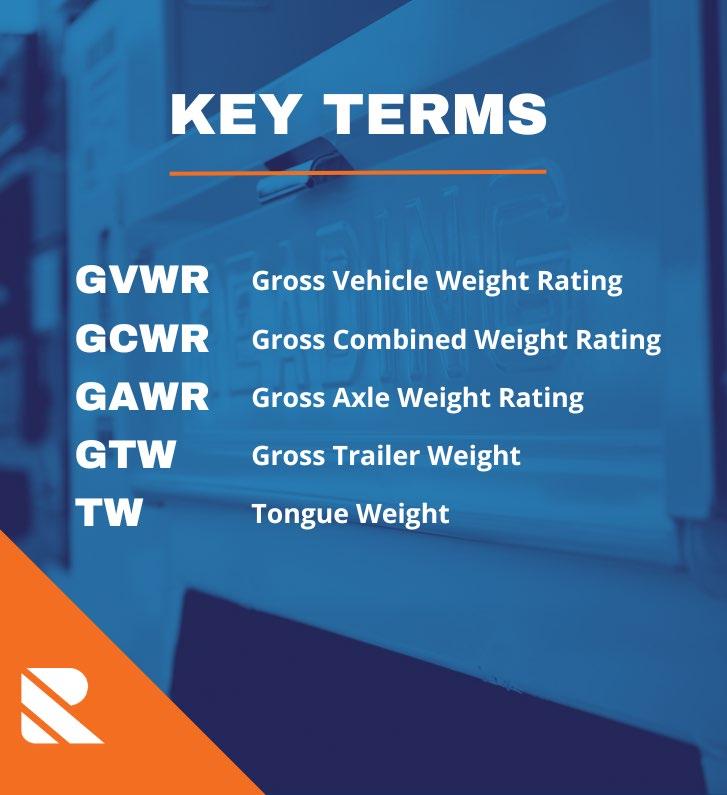

WHAT DOES GVWR MEAN?
The GVWR is the maximum safe loaded weight of a vehicle (or trailer), as determined by the manufacturer. GVWR isn’t just the weight of passengers and payload but also the vehicle. You can find a vehicle’s GVWR on the placard attached to the driver’s door pillar or consult the owner’s manual.
Trucks are classified by the U.S. Federal Highway Administration (FHWA) into classes based on GVWR, ranging from 1 – 8. Classes 1 & 2 are light duty; Classes 3 – 6 are medium duty; and Classes 7 & 8 are heavy duty.
and the weight of necessary operating fluids, such as fuel, oil, and brake fluid.
WHAT IS GCWR?
Do not confuse GCWR with GVWR. The former stands for gross combined vehicle weight rating while the latter represents the gross vehicle weight rating. GCWR is the maximum weight of a vehicle with a trailer attached, as determined by the vehicle manufacturer. Combined weight means the weight of both the tow vehicle and the trailer together. It also includes any cargo or load
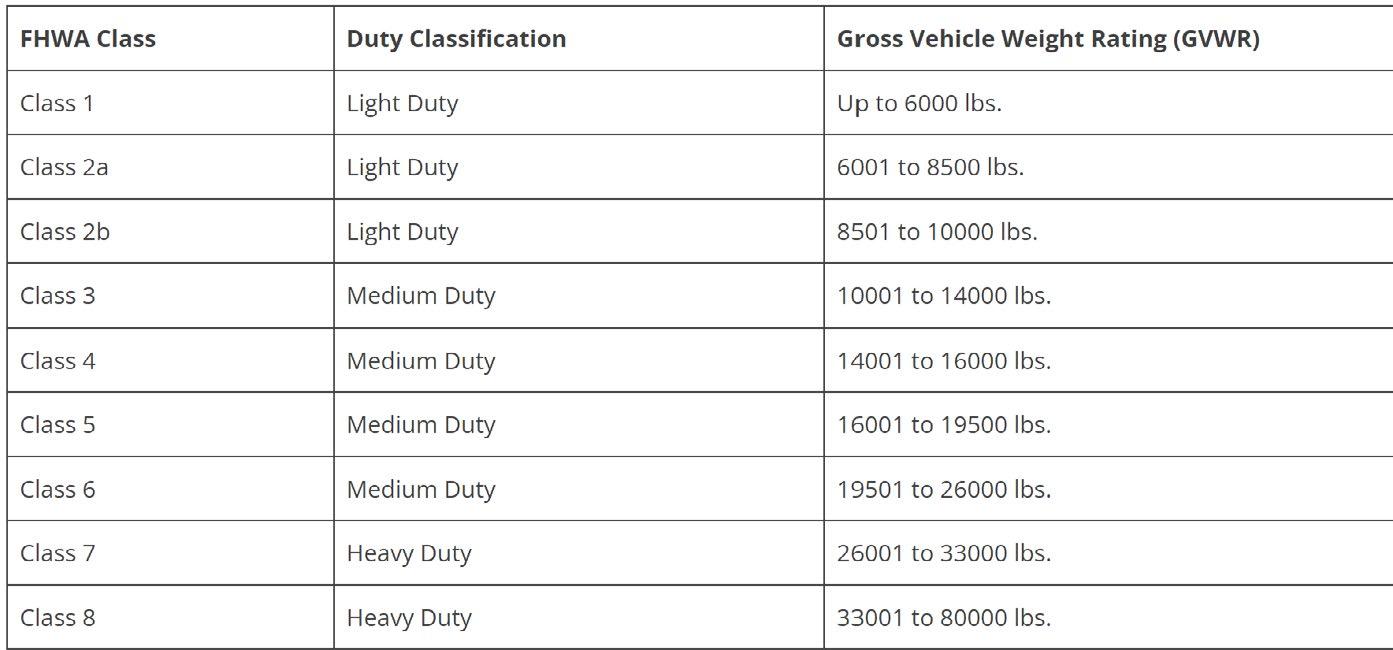
WHAT IS CURB WEIGHT?
A vehicle’s curb weight is the complete weight of the vehicle without any people or payload. The curb weight includes all the attached equipment of the vehicle
placed in either vehicle. The rating for gross combined vehicle weight is determined by the manufacturer, based on the strength of its frame, suspension, axles, brakes and other towing-related components.

JUNE 2024 | COMMERCIAL VEHICLE PRO 24
BLOG

WHAT IS TRAILER TONGUE WEIGHT?
Tongue weight (TW) is the downward force applied at a vehicle-trailer connection point when a trailer is connected for towing. The tongue weight should be between 10-15% of the total trailer weight. Measuring the tongue weight is essential to be certain that a trailer is loaded properly to ensure proper vehicle handling and steering. To measure tongue weight accurately, you can use a specialized tongue weight scale.
HOW TO CALCULATE PAYLOAD CAPACITY?
To calculate the payload capacity, you need to know both the curb weight and the GVWR. Subtract the curb weight from the GVWR to find the payload capacity.
For example, if you have a lightduty truck with a GVWR of 9,000 pounds and a curb weight of 6,000 pounds, the payload capacity will be 3,000 pounds:
GVWR – curb weight = payload capacity
9,000 pounds – 6,000 pounds = 3,000 pounds
This means that you can put an additional 3,000 pounds into a vehicle that may include people and cargo without any towing added.
If you had a trailer, you also need to subtract the tongue weight from the GVWR. For this same example, if you had a trailer that weighs 2,000 pounds, the tongue weight would be at least 200 pounds. The total payload capacity will now drop to 2,800 pounds:
GVWR – curb weight –tongue weight = payload capacity when towing

9,000 pounds – 6,000 pounds –200 pounds = 2,800 pounds
For instance, if you were to install a Reading SL service body on a single wheel , 98-inch bed and request steel lids, you will add 1,190 pounds to a truck. Installing this onto a 9,000-pound vehicle with a curb weight of 6,000 pounds will decrease payload capacity to 1,810 pounds:
GVWR – curb weight –truck body additions = payload capacity with truck add-ons
9,000 pounds – 6,000 pounds –1,190 pounds = 1,810 pounds payload capacity
WHY ARE THESE NUMBERS IMPORTANT?
Understanding and adhering to a vehicle’s maximum payload and towing capacity is not just a matter of convenience, but it is crucial for safety. Exceeding these limits can lead to problems such as reduced vehicle control, increased stopping distances, mechanical failures, or even serious accidents. By staying within these boundaries, you ensure not only the safety of a driver and passengers, but also of those sharing the road. So, before hitching a trailer or load up a truck, take a moment to calculate payload and towing capacity and
" UNDERSTANDING AND ADHERING TO A VEHICLE’S MAXIMUM PAYLOAD AND TOWING CAPACITY IS NOT JUST A MATTER OF CONVENIENCE, BUT IT IS CRUCIAL FOR SAFETY. EXCEEDING THESE LIMITS CAN LEAD TO PROBLEMS
HOW TO CALCULATE TRUCK TOWING CAPACITY?
To determine maximum towing capacity, you will need to know the vehicle manufacturer’s weight ratings and compare them against the gross weight of the trailer. Most vehicles have the trailer towing capacity listed in the owner’s manual, on the driver-side door jamb or in a trailer towing capacity guide on their website.
ensure that the tongue weight of the loaded trailer falls within 10 to 15% of the loaded trailer weight. The safety of all on the road depend on it.
Original Blog Published on readingtruck.com/about/blog

Commercial Vehicle Pro | JUNE 2024 25
SUCH AS REDUCED VEHICLE CONTROL, INCREASED STOPPING DISTANCES, MECHANICAL FAILURES, OR EVEN SERIOUS ACCIDENTS. " BLOG

ALL ABOUT ADVANCED FUEL SOULTIONS
EXPLORING YOUR FLEET EV CHARGING OPTIONS
AFor every business operating a commercial fleet, whether it comprises 3 or 300 vehicles, the combination of stringent mandates, strict regulations, and the imperative to minimize pollution compels fleet owners and managers to explore net-zero operations as an unavoidable necessity. One of the options is fleet electrification, and a critical aspect of commercial EV operations is charging the batteries.
The right EV charging options can significantly affect the operational efficiency and sustainability of commercial fleets, making the selection of EV charging solutions a critical decision for fleet managers. Let’s start with the basics.
UNDERSTANDING THE BASICS OF FLEET EV CHARGING
Fleet EV charging is not a onesize-fits-all proposition. Different fleets have unique needs based on vehicle types, usage patterns, and operational goals. Understanding the various charging levels and standards is crucial to tailoring the EV charging setup for a fleet. But first things first—the plug.
NACS vs. CCS
If you’re looking into fleet electrification, you’ve likely heard much ado about plug and protocol compatibility, specifically CCS vs. NACS (Tesla-style). The Combined Charging System (CCS) and the North American Charging Standard (NACS) are the two most common charging standards for EVs in North America, with the older SAE J1772 connector still in use on some lightduty vehicles.

The SAE J1772 is used in Level 1 and 2 charging systems.

The CCS 1 and 2 styles support Level 1, 2, and DC fast charging.

The NACS (Tesla-style) employs a hybrid connector, J3400, that supports Level 2 & DC fast charging.
NACS is often associated with Tesla, with CCS being the rival standard. However, as Ford and GM are also adopting the NACS, nearly every other EV manufacturer is following suit. Although compatibility between NACS and CCS is possible via a common plug adapter, this is becoming a moot point as the NACS, or Tesla-style, plug is quickly emerging as the de facto standard for North America.
So, no matter the style plug on an EV, adapters eliminate the worry of compatibility issues. Not to mention that NACS plugs will be standard equipment on most EV vehicles by 2025.
WHAT IS LEVEL 1 CHARGING?
Level 1 EV chargers are simple units that plug into a standard 120v electrical outlet at one end and come with a North American standard J1772 connector at the other. Many units offer a NACS adapter, which is a simple, low-cost solution for light-duty EV charging.
Charging speed: Adds about 2 to 5 miles of range per hour of charging, making it the slowest charging option.
Best for: Fleets consisting of light-duty vehicles traveling up to 40 miles per day, with overnight parking or longer downtime periods. Ideal for supplementary charging or scenarios with minimal daily mileage.
Purchasing insights: These portable chargers can easily be purchased online or from automotive retailers. They provide flexibility and ease in charging operations without the need for significant setup or infrastructure overhaul.
WHAT IS LEVEL 2 CHARGING?
Level 2 charging stations are a more robust solution than Level 1. They provide electricity at 240V, similar to what large appliances use in a home, facilitating quicker charging times and increased efficiency. Level 2 chargers are available in both portable plug-in style and permanent installation. The plug-in styles will use one of the SAE 240v plugs, while installation requires the services of a qualified electrician.
Level 2 is considered by many to be the threshold for medium-duty commercial EVs.

JUNE 2024 | COMMERCIAL VEHICLE PRO 26
Charging Speed: Capable of adding about 10 to 60 miles of range per hour of charging. The charging speed can vary based on the EV's onboard charger.
Best for: Fleets consisting of light and medium-duty vehicles traveling up to 400 miles per day (or battery limit). It is suitable for overnight charging or top-ups throughout the day. Obviously, vehicles traveling further during a work shift will require longer to charge.
Purchasing insights: These chargers can also be purchased online or from specialized EV equipment suppliers or automotive retailers. A mobile configuration presents a flexible option, allowing businesses to utilize advanced charging capabilities without the commitment to a fixed location.
Subscription services for Level 2 charging are increasingly prevalent, providing the equipment and ongoing maintenance and updates for a monthly fee. This model is particularly appealing for organizations looking to minimize upfront investment while ensuring their charging infrastructure remains cutting-edge.
WHAT IS DC FAST CHARGING?
Levels 1 and 2 charging deliver alternating current (AC) to your vehicle. Because batteries operate on direct current (DC), your vehicle must convert the incoming AC to DC, creating a bottleneck. DC fast charging (DCFC), sometimes referred to as rapid or ultra-fast, delivers a large quantity of DC current from the charger, eliminating the need for your car to make the conversion. This results in significantly faster charging than Level 1 or Level 2.
The DCFC technology involves much more power and requires a more specialized, high-capacity infrastructure.
Charging Speed: Can add 60 to 100 miles of range in about 20 minutes,

depending on the station's power output and the vehicle's maximum charging capacity.
Best for: Fleets with medium and/or heavy-duty vehicles. DC fast charging is also better suited for light-duty fleets with high-utilization schedules that require quick turnarounds. It is ideal for routes with accessible DC fast charging stations or for emergency top-ups.
Purchasing insights: The purchasing options available to EV fleets seeking DC fast charging stations are diverse and must be tailored to your company’s specific situation.
When planning to install a DC fast charging station at a company site, the primary considerations would involve station capacity: Can the facility draw 200V-920V? Is there physical space required for station installation?
KEY CONSIDERATIONS FOR FLEET EV CHARGING OPTIONS
Once you’ve assessed which charging level will meet your needs, the next decision is whether to install on-site charging infrastructure or rely on public charging stations.
INSTALLING ON-SITE FLEET CHARGING STATIONS
One of the primary advantages of depot (on-site) charging is the potential for cost savings. In comparison to on-route or public charging, depot charging can be more economical due to the ability to optimize charging schedules during off-peak electricity rate periods, thus lowering operational costs[1]. Additionally, on-site charging can significantly improve operational efficiency by ensuring that vehicles are charged and ready for their routes according to the fleet's schedule, without depending on the availability of public charging infrastructure[1].
Moreover, on-site charging infrastructure allows for a controlled

charging environment, where fleet operators can directly manage how, when, and to what extent vehicles are charged. This can lead to increased reliability and the ability to rapidly respond to any operational exigencies without being constrained by external factors such as the availability of public charging stations[1].
There are also several government incentives, such as the federal Alternative Fuel Infrastructure Tax Credit and California’s Charging Station Grants, that can lower the upfront costs of EV charging installations. However, the costbenefit analysis of different EV charging options requires careful consideration of both upfront and ongoing maintenance costs.
For fleets specifically, companies like Eaton, EVESCO, Kempower, and several others, offer a comprehensive line of EV charging station solutions designed to meet the diverse needs of vehicle fleets.These solution providers possess a wealth of knowledge that’s indispensable when it comes to the assessing and planning stages of a fleet electrification journey.
There are also organizations, such as Merchants Fleet, Dynamon, and CA.gov that provide EV transition consulting. They can help with many of the questions concerning everything from product to planning to financing.
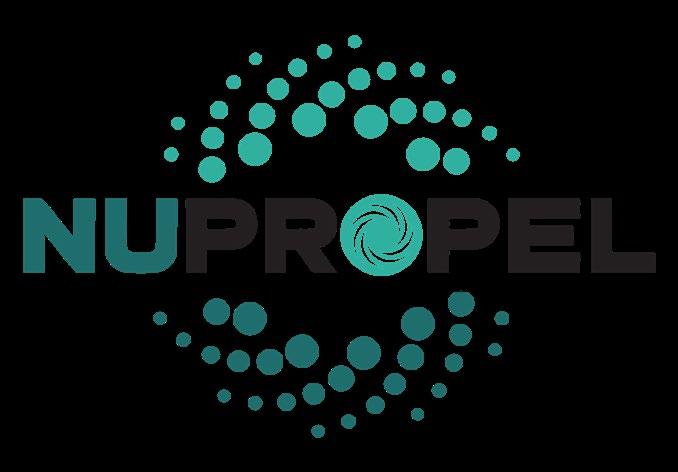
READ THE REST OF THE ARTICLE ON COMVOY.COM'S * * * * * * * * * * * * * * Commercial Vehicle Pro | JUNE 2024 27 EXPLORING YOUR FLEET EV CHARGING OPTIONS

ALL ABOUT ADVANCED FUEL SOULTIONS
NAVIGATING BEYOND DIESEL:
ESSENTIAL CONSIDERATIONS FOR ALTERNATIVE FUELS
It’sno longer a question of whether fleet owners will have to consider a transition to clean alternative fuels. Now the question is which alternative energy source makes the most sense for each fleet.
It can feel like a monumental task to do the research on multiple energy options. While an environmental benefit is the ultimate goal, fleets shouldn’t have to compromise in other areas to make it a reality.
Fleet owners can start their research by asking about the benefits of an alternative energy source in four main categories: the environment, finances, operations, and availability. If an alternative energy source can provide advantages in each of those areas, it’s worth digging deeper to find out more. Here are criteria to help fleet owners answer each question and explain how propane autogas might provide benefits for your fleet, no matter the size.
Environmental Benefits of Propane Autogas In Commercial Vehicles
Fleets will certainly reduce emissions by switching from a diesel or gasoline fleet. But fleet owners should dig a little deeper to learn if the environmental benefit might force them to compromise elsewhere. They should understand if the energy source will reduce emissions over the vehicle's lifecycle without increasing cost or losing efficiency.
For instance, propane autogas is an ultra-low emissions energy source with near-zero particulate matter emissions and nitrogen oxide (NOx) emissions that are 90 percent lower than the Environmental Protection
Agency (EPA) standards.
The National Renewable Energy Laboratory, the Department of Energy’s Office of Energy Efficiency & Renewable Energy, and the Propane Education & Research Council recently partnered on a real-world study evaluating the emissions reductions of a propane autogas engine compared to diesel. Five propane autogas and 15 diesel class 6 box trucks were outfitted with data loggers during normal operation for two one-month periods in Colorado. The findings showed the propane autogas engines reduced CO2 emissions by 18.9%, NOx emissions by 98%, and SOx emissions were virtually eliminated.
Financial Benefits of Propane Autogas In Commercial Vehicles
At the end of the day, a fleet can’t be environmentally sustainable if it can’t be financially sustainable. Fleet owners need an alternative energy source that provides a return on investment long before the end of the vehicle lifecycle.
Propane autogas has the lowest total cost of ownership of any fuel when you factor in the price of the vehicle, fuel, fluids, maintenance, and repairs over the lifetime of the vehicle.
Propane autogas typically costs 40-50 percent less than diesel. And because propane autogas is a clean energy source, the engine is less costly to maintain than diesel since it doesn’t require expensive exhaust after-treatment systems diesel engines need to meet emission standards.
The Colorado study of the class-6 box trucks underscores these cost reductions. The propane autogas vehicles saved over $20,000 per vehicle in the first 12 months of the project compared to their diesel counterparts.

Operational Benefits of Propane Autogas In Commercial Vehicles
When it comes to operations, the question is whether the vehicle performs as well as or better than the original energy source without compromising on range.
Many medium-duty work truck fleets run on propane autogas because they need a range of 100 to 400 miles per day and the ability to carry a heavier payload. Not every energy source can meet those needs. For instance, electric vehicles will typically need to recharge long before a propane autogas vehicle needs to refuel.
As for performance, propane autogas engine technology has evolved in the last decade, bringing fleet owners performance comparable to gasoline or diesel. In fact, in the Colorado study, the data found that propane autogas trucks achieved similar duty cycles to diesel trucks.

JUNE 2024 | COMMERCIAL VEHICLE PRO 28


But unlike diesels, propane autogas trucks also provide the added benefit of needing fewer filters and fluids to meet Tier 4 emissions standards, resulting in more uptime.
more than 1,500 public refueling stations available in the U.S., propane suppliers will work with fleet owners to set up private, customizable refueling infrastructure at low cost.
Transitioning to an alternative fuel doesn’t have to be a scary decision. By asking the right questions upfront to help guide research, fleet owners will be able to make an informed decision on how to meet their environmental, financial, and operational goals.
Availability of Commercial Vehicles Powered By Propane Autogas
Finally, fleet owners need to consider the availability of any new energy source. To ensure their fleet can remain operational, there needs to be a high-volume supply of the new energy source readily available everywhere and at any time.
Propane autogas is available now, in abundance, in communities all across America. In addition to the

Fleet owners can feel good knowing propane autogas infrastructure can easily scale with the fleet, and there are no concerns about infrastructure availability, unlike many other energy sources.
Plus, because propane autogas is a portable energy source, it can be delivered to all parts of the country regularly and in times of need. Even when the electric grid goes down, rendering EV charging or gasoline
stations inoperable, propane autogas can continue to be delivered and pumped into vehicles. This added layer of resiliency provides peace of mind for fleet owners.

Transitioning to an alternative fuel doesn’t have to be a scary decision. By asking the right questions upfront to help guide research, fleet owners will be able to make an informed decision on how to meet their environmental, financial, and operational goals.
 By Tucker Perkins, President and CEO, PERC Propane Education & Research Council tucker.perkins@propane.com
By Tucker Perkins, President and CEO, PERC Propane Education & Research Council tucker.perkins@propane.com
BEYOND
NAVIGATING
DIESEL
Commercial Vehicle Pro | JUNE 2024 29





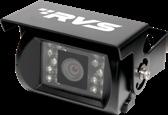

Trusted Fleet Safety Experts from our family of brands continue the mission of providing best-in-class solutions for fleet vehicles, from Last-Mile Shelving to Ladder Racks and Tractor-Trailer Wireless Camera Systems.

YOUR SINGLE SOURCE FOR INDUSTRY-LEADING WORK TRUCK SOLUTIONS
safefleet.net
SCAN QR-CODE BELOW TO LEARN MORE OR VISIT – WWW.SAFEFLEET.NET/WORKTRUCK-SAFETY SCAN FOR MORE
RECOMMENDATIONS SERVE AS PRIMARY TRIGGERS TO SHOP FOR TELEMATICS
By Lucas Lowden, Program Lead of Escalent’s Fleet Advisory Hub™
Author’s Note: While this article is written to an audience of telematics service providers, if you are a business that operates vehicles – I encourage putting the shoe on the other foot – and taking potential service providers to task about meeting your business where it is, and outline how to best meet your business needs for connected solutions.
For all service providers and vehicle-based business decisionmakers alike, you’re not alone on this journey, and if you want to have your voice heard and collaborate with industry peers you can join here to participate in our FAH Community research program, from Escalent in partnership with Work Truck Solutions and Comvoy.
The telematics market is poised for a surge of growth in the coming years. The evolving regulatory landscape, a growing appetite for connected technologies and the ever-present pressure to remain competitive are all prompting fleet businesses to investigate the benefits of telematics solutions.
Escalent’s Telematics Path to Purchase report from our Fleet Advisory Hub™ insights program, which explores the needs, expectations and emotions of commercial vehicle and fleet decision-makers, aims to map this developing market by examining the process and behaviors exhibited by fleet decision-makers as they shop for, make decisions about, and ultimately onboard telematics solutions.
As our data demonstrate, the fleet telematics market is still in the late stages of early adoption. Of the 1,000 fleet professionals we talked to, only one-third (34%) have adopted a telematics solution, with more than 80% being first-time buyers.
With two-thirds of fleet leaders yet to lock in a telematics solution, there remains a significant opportunity for service providers to capture and expand their market share.
THE IMPACT OF WORD OF MOUTH ON FLEET DECISION-MAKERS
Various factors are spurring fleet decision-makers to begin researching telematics solutions, but two stand out. Nearly half (44%) of decision-makers say a recommendation triggered their purchase journey. Further, around one-third (35%) report they began their search in response to an internal business improvement initiative wherein top-cited motivations include improving vehicle tracking (49%), increasing fleet productivity (41%) and enhancing safety (39%).
For the 44% of fleet leaders following a recommendation to invest in telematics technology, 28% of recommendations came from industry peers, 25% from colleagues and 20% from telematics service providers (TSPs). This emphasis on word of mouth
presents an opportunity for TSPs to enhance their penetration in the market through recommendations while simultaneously putting the onus on providers to ensure they consistently meet or exceed customer expectations and thus remain top of mind for potential referrals.
A NONLINEAR SHOPPING PROCESS FOR FLEET TELEMATICS SOLUTIONS
Once these professionals are engaged in the shopping process, the path to purchase is by no means linear or unilateral. On average, fleets involve two departments in the prepurchase phase—with 32% of businesses involving three or more departments. Further, 68% say they employ a joint decisionmaking process.
Shoppers are taking their time when choosing a telematics provider, too. Those who have adopted the technology spent an average of eight months investigating solutions before implementing them. Our data indicate that new adopters will be even more deliberate in their research and planning. Current shoppers say they have already spent an average of seven months considering offerings and anticipate it will be another nine until they purchase and integrate a telematics solution into their fleet business.


Commercial Vehicle Pro | JUNE 2024 31
RECOMMENDATIONS SERVE AS PRIMARY TRIGGERS TO SHOP FOR TELEMATICS
To successfully move fleets down the telematics purchase funnel, service providers will need to be sensitive to this dynamic, being able to identify where fleet decisionmakers are in their telematics shopping journey and taking the time to deeply understand the objectives and needs of the fleet business in question. Then service providers can ensure their marketing strategies and consultative services align with their customers’ progress toward telematics procurement.
OPEN MINDS AND AMPLE OPPORTUNITY FOR TELEMATICS PROVIDERS
When weighing where to shop for a telematics solution, fleet leaders in our study gravitate toward a group of “big four” providers—two telecommunications brands and two vehicle manufacturers—that fleets are often already partnered with, and trust. More than onethird (36%) of decision-makers say Verizon Connect is in their
consideration list. AT&T Fleet Complete ranks second (28%), followed by Ford Pro Telematics (27%) and OnStar Business Solutions (26%).
That said, fleet shoppers are also curious about dedicated TSPs.
Fourteen percent would include Geotab and TomTom in their consideration lists, and 11% would include Omnitracs and Samsara.
Note: There are many telematics service providers in the market, though not all were included in our evaluation, including the program recently announced from Stellantis/Ram commercial solutions group.
There is space for other automotive industry partners to drive the purchase journey, too. While 57% of fleet leaders list TSPs as a shopping channel, vehicle manufacturers and dealers (38%), fleet management companies

(35%) and transportation management system providers (27%) are also popular. With no majority leader among providers, these decision influencers could establish a foothold in the market by solidifying a partnership with a dedicated TSP.
CONNECTING SMALL AND MID-SIZED FLEETS WITH TELEMATICS SOLUTIONS
At present, fleets running at least 50 vehicles are setting the pace for adoption. Sixty-six percent of large fleets (500 vehicles or more) and 55% of mid-sized fleets (51 to 499 vehicles) say they have adopted telematics at some level. As smaller fleets come to the table, service providers typically find their demands differ from those of their larger counterparts. Providers must focus on developing flexible value propositions that resonate with a range of fleet stakeholders and reflect the needs of a variety of business models. This is vital for long-term growth as well as for the nearer-term opportunity to connect small and mid-sized fleets with telematics solutions that meet their objectives and smaller budgets.
Fleet decision-making is collaborative and involved, and although the market has been shaped by the preferences of the largest players in the business, it is gradually shifting toward smaller fleets and mixed fleet businesses. The service providers who try to understand how fleets of all sizes are approaching the telematics purchase journey will be best placed to align their products and messaging with the expectations of the next generation of adopters and, in doing so, take the lead in connecting the fleet.

JUNE 2024 | COMMERCIAL VEHICLE PRO 32
MOVING THE TELEMATICS MARKET BEYOND THE LATE STAGES OF EARLY ADOPTION
Despite existing for more than a decade, the telematics industry needs to move beyond early adopters. Fortunately, there is plenty of room for growth. Most fleet decision-makers have little unaided recall of telematics brands and, although the “big four” are trusted brands that have strong reputations and top the list for highest initial shopping consideration, there is ample opportunity to challenge them, as fleet leaders are open to shopping for telematics solutions through other partners in their circle.
To grow mindshare among fleet decision-makers and establish leadership, telematics providers need to do three key things:
1. Deeply understand the different telematics purchase journeys, objectives, challenges and needs of diverse fleet stakeholders and different business sizes
2. Tailor offerings, marketing and value propositions/messaging to specific customers’ pain points and priorities
3. Deliver solutions that perform as promised, or better, and ensure strong post-sale customer experience to facilitate positive word-of-mouth recommendations

LET’S WORK ON MAKING WORK EASIER.
If you would like to learn more about our findings, Fleet Advisory Hub, or how our commercial vehicle and fleet experts can help you grow your business, please reach out to us.



It starts by designing truck bodies with innovative features so you can work smarter and safer. Next, we use American craftsmanship to build durable bodies you can count on year after year. If you need an air compressor, an extra toolbox or special work lighting, we can outfit your body your way. You’ll even find maintenance, crane inspections and mobile service. Everything you need in one work truck company to help you work smarter. Save time and money. Send productivity soaring. Let’s work.
readingtruck.com
Learn more:
BE
TO VISIT THE FLEET ADVISORY HUB TO CONNECT WITH OTHER LIKE MINDED TRUCK PROS! RECOMMENDATIONS SERVE AS PRIMARY TRIGGERS TO SHOP FOR TELEMATICS Commercial Vehicle Pro | JUNE 2024 33
SURE
CVProPro-File
David Rittenhouse, an esteemed member of Bergey’s GMC, boasts a seasoned career stretching over two decades in commercial light-duty truck sales. With a background in heavy-duty trucking, David's career took a pivotal turn when his aptitude for commercial sales was recognized, propelling him into his current position at Bergey's GMC store.
 David Rittenhouse
David Rittenhouse
online—an approach he deems crucial in today’s market.
Beyond the bustling world of commercial vehicle sales, David engages in diverse outdoor activities. He takes joy in hunting, fishing, and biking. Seasons find him engaged in the bucolic charm of farm life, where he offers hay rides to visitors, all the while cherishing precious moments with his grandchildren. When craving something a little more exciting, you might find David at a NASCAR event getting his adrenaline fix.

All in all, David Rittenhouse's profile paints the picture of a dedicated and self-made professional with a
WATCH

Confronted with the swift retirement of his predecessors, David mastered his craft in what one might describe as ‘baptism by fire.’ This hands-on learning experience, while challenging, led to a unique self-taught expertise.
At Bergey's GMC, David's role extends beyond ordering and selling commercial vehicles. It's a platform for him to channel his passion for working with contractors, fleets, and truck enthusiasts. His expertise in the field makes him an invaluable asset to his commercial department.
Technology plays an integral role in David's day-to-day activities, where he employs a CRM to foster communication with customers and manage leads effectively. Alongside his adept team, he leverages the Work Truck Solutions website to showcase the dealership's robust inventory through vivid imagery



zest for the commercial vehicle industry and an ardent love for family and outdoor adventures.




 Watch or Listen to CVBNetwork's interview with David Rittenhouse at the 2024 Work Truck Week
Watch or Listen to CVBNetwork's interview with David Rittenhouse at the 2024 Work Truck Week
LISTEN JUNE 2024 | COMMERCIAL VEHICLE PRO 34
CVProPro-File
With a background in construction and industrial work, Mike Kelly now serves as the dedicated Commercial and Fleet Department Director at Mike Shaw CDJR.
Transitioning from a 3-year stint in retail car sales and leveraging his background as a contractor, Mike integrated his knowledge of construction and commercial vehicles with his experience in the car business. His journey with the Mike Shaw dealership began seven years ago, marking a decade of his involvement in the automotive industry, with the last seven years focused on commercial vehicles.
In his current role, Mike oversees

inventory, finance, and warranty operations alongside managing a team of three account managers. His responsibilities are pivotal to the dealership's success, fostered within the Asbury Automotive Group. The group is recognized as the eighth largest in the United States, allowing Mike significant scope for collaboration across a range of dealerships, particularly benefiting from the ecosystem of the Larry H. Miller Group and others in the western U.S. Though based primarily at the Greeley, Colorado location, his role necessitates travel to assist customers throughout these connected networks.








One of Mike's most valued technological tools is surprisingly simple yet highly impactful—a gimbal and a cell phone. This setup has revolutionized how he engages potential buyers by facilitating the creation of video content. These videos, effortlessly integrated into the inventory on Work Truck Solutions and shared via his YouTube channel, enable Mike to offer immediate, visual insights into the vehicles that buyers are interested in. This approach positions him more as a consultant than a salesman, enhancing customer trust and streamlining the purchasing process.
Outside his professional endeavors, Mike's life is rich with personal commitments and passions. A devoted family man, he's been married for 21 years to his sweetheart, Sarah, with whom he shares three children. When not immersed in the automotive world, Mike dedicates his time to coaching and mentoring, serving as a football coach for the Loveland Mountain Lions in Colorado. This role allows him to impact the lives of about 75 young athletes, coaching, training, and teaching—activities that he ranks among his most cherished pastimes beyond his family life.
Watch or Listen to CVBNetwork's interview with Mike Kelly at the 2024 Work Truck Week
Mike Kelly
WATCH LISTEN Commercial Vehicle Pro | JUNE 2024 35
NEWS & EVENTS TOOLBOX
ACT EXPO MAINSTAGE DRIVES DISCUSSION ON CLEAN TECH INDUSTRY’S NEXT STEPS

This year’s ACT Expo Mainstage did not disappoint, with speakers from every sector of the industry — innovators who were not afraid to ask, and answer, the tough questions and challenges facing the commercial transport industry. From Tesla Semi project lead Dan Priestley to J.B. Hunt President Shelley Simpson, this year’s attendees were presented with varying views of the electrification of the trucking industry, surprising revelations on the future of internal combustion engines, and an intriguing comparison to the evolution of the cell phone. More than 12,000 commercial transportation stakeholders gathered at the Las Vegas Convention Center for this year’s event, packed with four days of fleet-focused educational sessions and a historic tradeshow floor featuring advanced transportation technologies from 400-plus top suppliers for all vehicle weight classes and fleet applications.
HERE is the keynote presentation by Ryder System CEO Robert Sanchez. As an early adopter in the clean fuels space, Sanchez has spent more than a decade shaping the way that Ryder determines and reaches its emission reduction goals. But to place a bigger bet on EVs, Sanchez called for a catalyst to make battery-electric technology more economically and operationally feasible for the commercial trucking industry. During his keynote address at this year’s ACT Expo in Las Vegas, Sanchez did not pull any punches on how he sees electric trucks fitting into his fleet.
For full access to this year’s ACT Expo video keynotes, panels, and more, including all the presentations from the event, email registration@trccompanies.com. For $450, you can watch the 2024 ACT Expo mainstage speakers discuss the next steps in the journey toward more economic and environmentally sustainable transport solutions.


JUNE 2024 | COMMERCIAL VEHICLE PRO 36
COMMERCIAL TRUCK TRAINING
STRENTHENING CONNECTIONS
Whenwe introduce the section of our refreshed Ultimate Boot Camp called Follow Through (as opposed to the cringy Follow Up), we ask our group two questions:
“What was a memorable time someone impressed you with following through?”
“When was the last time you impressed someone with following through?”
There’s usually silence after the second question. There is so much focus on the process of the sale, even in fleet and commercial, that the customers you’ve collected get moved to the back burner. Sure, they’re still on your stove, and you give them attention when needed, but they are not much of a focus anymore.
How do you solve that? You put as much emphasis on your current book of business as you do your prospects. After all, it’s easier to convince someone who has already bought a vehicle from you to buy another, so long as you’re doing the right things.
Here are three different ways to keep the conversation flowing, with value naturally attached.
Networking Groups and Trade Associations
This should be standard practice for you. It doesn’t matter necessarily which associations you’re a part of, so long as the connections provide potential for you and you take the time to get involved! Think of the efficiency of seeing your customers and prospects on a regular basis, in a networking-friendly setting. Think about the connections your current customers can help you make to their partners you’re trying to get in the door with. Stay active, get on a committee, sponsor events, and have a goal to meet three new people at every meeting while keeping in

connection with your current base. Your number of sales contacts alone should skyrocket just from associations… and gatekeepers don’t go to these meetings.
Fleet Cycling
The mere discussion of fleet cycling presents a unique opportunity to stay connected with clients while offering added value. Proactive fleet management initiatives, such as offering maintenance reminders, performance reports, and fleet optimization recommendations, demonstrate a commitment to client success beyond the initial sale. That sure sounds like an opportunity for a “regularly scheduled interval” to keep in contact with your customers, doesn’t it? Now add in your knowledge of lead times, specialty upfit details, and enough data on their fleet, and you become someone to be relied on for any business owner or fleet manager.
Social Networking
When was the last time you heard the phrase above, as opposed to “social media?”
Sure, everything on those various channels is media in some form, otherwise it wouldn’t draw our attention. There are some impressive individuals in commercial and fleet that have gone “viral” to a degree, but you do not need big numbers to succeed. You need content that –when your prospect does check you out – they come away feeling as though you are a resource they can trust.
If you focus your efforts on networking – meaning posts containing other people, businesses, and organizations – you will establish a quality following organically. A solid general recommendation is to have equal parts of the following posts: vehicles (segmented walkarounds),
people (testimonials and networkingrelated activities), and educational (specific how to videos, incentives or tax breaks, etc).
Effectively, you need content that allows prospects to come away feeling as though you are a resource they can trust, and when a customer visits your channels, they see that you keep your word on being a quality connection worth keeping as a partner in growing their business.
“When was the last time you impressed someone with following through?”
You can answer that question for yourself by examples like what was just covered. By putting an emphasis on your post-sale activities in a way that you would any other successful self-improvement process, you have a head start on most competition already.
Look for opportunities, create a realistic system worth executing, and find a little daily reward that works for you. Then start, adjust, learn, and above all, keep going.
By Will Brogan, Commercial Truck Training
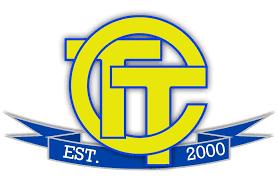
For more information about Commercial Truck Training: 1-904-535-9996 www.commercialtrucktraining.com Ken Taylor ken@coachkentaylor.com Will Brogan will@commercialtrucktraining.com
Commercial Vehicle Pro | JUNE 2024 37
DEALERSHIP SUCCESS
Shawn Horswill - Work Truck Solutions, SR VP of Product
BUILDING BRIDGES: THE POWER OF HUMAN CONNECTIONS IN THE COMMERCIAL VEHICLE INDUSTRY
Amid the bustling season of commercial vehicle expos and trade shows, "Connecting the Dots" was not merely the theme for the Commercial Vehicle Business Summit Spring 2024; it was a clarion call. This phrase underscored the pivotal role of human connections within the complexity of commerce and technology.
Let's explore these connections and their vital impact on the success of commercial vehicle dealerships.
The Essence of Human Connections in the Commercial Vehicle Industry
Human connections in our context go beyond mere transactional interactions. What we're really talking about are meaningful engagements and relationships among various stakeholders. Manufacturers, dealerships, customers, service providers, and upfitters form the nexus of a complex network. Within this web, each thread represents the potential for collaboration, innovation, and growth, making interconnectivity not just beneficial but essential.
The Impact Of Strong Relationships on Dealership Success
Dealerships thrive on the bedrock of strong relationships. Always have. Enhanced customer loyalty and repeat business spring from the trust and rapport built over time. Word-of-mouth, a powerful ally, elevates brand reputation,
translating into tangible success metrics. Moreover, the operational harmony fostered through solid connections with business partners enables smoother transactions and fosters an environment ripe for constructive feedback; the kind that propels product and service evolution.
Strategies for Nurturing Lasting Connections
Communication stands at the heart of relationship-building. However, in our industry, traditional methods must evolve.
Leveraging technology can bridge distances yet, with thoughtful interaction, we can also maintain the personal touch critical to our industry. Dealerships can integrate technologies such as chatbots, virtual reality, and artificial intelligence to provide informative and engaging digital experiences. However, it's crucial to maintain a balance where these digital interactions are complemented by personal touchpoints, ensuring customers feel valued and understood on a personal level. Utilizing customer data and advanced CRM systems allow dealerships to better understand the people they're interacting with, and if used to build personal profiles, can help dealership associates to relate to stakeholders as human beings. Additionally, community engagement and participation in industry events offer avenues to network and build the kind of human connections that contribute to lasting success.

Challenges and Solutions in Maintaining Connections
Naturally, the path to sustaining relationships is fraught with challenges, from the ever-present time constraints to the evolving landscape of customer expectations. Flexibility and a commitment to continuous improvement emerge as beacons to navigate these waters. Remember that every stakeholder, although representing a professional interest, is still a person with needs, limitations, and emotional complexities. Adopting a mindset geared towards innovation, adaptation, and service ensures that your dealership can overcome obstacles and nurture connections that weather time and change.
Conclusion
As we contemplate the weave of human connections within the commercial vehicle industry, the undeniable conclusion is that they play a quintessential role in our success—and the success of all those we deal with. Success for all of us depends on a deep understanding of the human element.
Creating and maintaining connections is not only advisable but imperative for those seeking to thrive. Because, at the end of the day, these human connections turn the wheels of dealership success.
BE

SURE TO CONTACT SHAWN AT SHAWN.HORSWILL@ WORKTRUCKSOLUTIONS.COM FOR MORE TIPS JUNE 2024 | COMMERCIAL VEHICLE PRO 38














 RUB RAILS
RUB RAILS

















































































 By Tucker Perkins, President and CEO, PERC Propane Education & Research Council tucker.perkins@propane.com
By Tucker Perkins, President and CEO, PERC Propane Education & Research Council tucker.perkins@propane.com





























